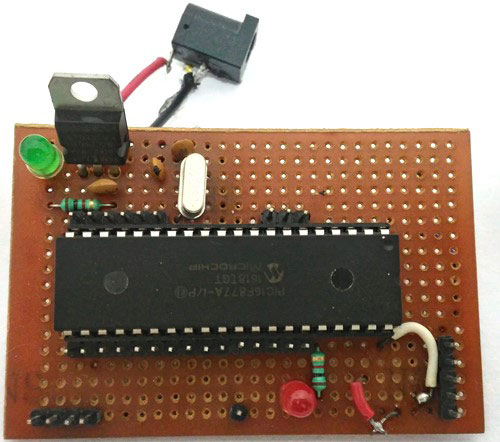

如何使用PIC16F877A和ACS712-5A制作数字电流表
描述
在制作或调试任何电气系统时,测量电压和电流总是有帮助的。在这个项目中,我们将 使用PIC16F877A微控制器和电流传感器ACS712-5A制作自己的数字电流表 。该项目可以测量0-30A范围内的交流和直流电流,精度为0.3A。只需对代码进行少量修改,您也可以使用此电路测量高达30A的电流。
所需材料:
- PIC16F877A
- 7805 稳压器
- ACS712 电流传感器
- 16*2液晶显示屏
- 接线盒和负载(仅用于测试)
- 连接线
- 电容器
- 面包板。
- 电源 – 12V
ACS712电流传感器的工作原理:
在我们开始构建项目之前,了解 ACS712 电流传感器的工作原理对我们来说非常重要,因为它是项目的关键组件。测量电流,尤其是交流电流始终是一项艰巨的任务,因为噪声加上不正确的隔离问题等。但是,借助由Allegro设计的ACS712模块,事情变得容易多了。
该模块的工作原理是霍尔效应,这是由埃德温·霍尔博士发现的。根据他的原理,当载流导体被放入磁场中时,在其边缘垂直于电流和磁场方向产生电压。让我们不要太深入这个概念,简单地说,我们使用霍尔传感器来测量载流导体周围的磁场。该测量将以毫伏为单位,我们称之为霍尔电压。该测量的霍尔电压与流过导体的电流成正比。
使用 ACS712 电流传感器的主要优点是可以测量交流和直流电流,它还在负载(交流/直流负载)和测量单元(微控制器部分)之间提供隔离。如图所示,模块上有三个引脚,分别是Vcc,Vout和接地。

2 针接线端子是载流线应穿过的位置。模块工作在+5V,因此Vcc应由5V供电,接地应连接到系统的地。Vout引脚的失调电压为2500mV,这意味着当没有电流流过导线时,输出电压将为2500mV,当电流为正时,电压将大于2500mV,当电流为负时,电压将小于2500mV。
我们将使用 PIC 微控制器的 ADC 模块来读取模块的输出电压 (Vout),当没有电流流过导线时,输出电压为 512(2500mV)。当电流以负方向流动时,该值将减小,当电流沿正方向流动时,该值将增加。下表将帮助您了解输出电压和ADC值如何根据流过导线的电流而变化。

这些值是根据 ACS712 数据表中给出的信息计算得出的。您也可以使用以下公式计算它们:
Vout Voltage(mV) = (ADC Value/ 1023)*5000
Current Through the Wire (A) = (Vout(mv)-2500)/185
现在,我们知道了ACS712传感器的工作原理以及我们可以从中得到什么。让我们继续看电路图。
电路图:
下图显示了该数字电流表项目的完整电路图。

完整的数字电流计电路工作在+5V电压下,由7805稳压器调节。我们使用 16X2 LCD 来显示电流值。电流传感器 (Vout) 的输出引脚连接到 7^千^PIC的引脚,即AN4,用于读取模拟电压。
此外,PIC 的引脚连接如下表所示
| S.No: | 引脚编号 | 引脚名称 | 已连接到 |
|---|---|---|---|
| 1 | 21 | RD2 | 液晶显示器的 RS |
| 2 | 22 | RD3 | 液晶显示器的E |
| 3 | 27 | RD4 | 液晶屏D4 |
| 4 | 28 | RD5 | 液晶屏D5 |
| 5 | 29 | RD6 | 液晶屏D6 |
| 6 | 30 | RD7 | 液晶屏D7 |
| 7 | 7 | AN4 | 当前塞斯诺的沃特 |
您可以在面包板上构建此数字电流表电路或使用性能板。如果您一直遵循PIC教程,那么您还可以重用我们用于学习PIC微控制器的硬件。在这里,我们使用了与PIC微控制器一起为LED闪烁构建的相同 性能板 ,如下所示:

注意: 构建此板不是强制性的,您可以简单地按照电路图在面包板上构建电路,并使用任何转储器套件将程序转储到 PIC 微控制器中。
模拟:
在您实际使用硬件之前,也可以使用 Proteus 模拟此 电流表电路 。分配本教程末尾给出的代码的十六进制文件,然后单击播放按钮。您应该能够注意到LCD显示屏上的电流。我使用灯作为交流负载,您可以通过单击它来改变灯的内阻以改变流过它的电流。

如上图所示,电流表显示流过灯的实际电流约为 3.52 A,LCD 显示电流约为 3.6 A。但是,在实际情况下, 我们可能会得到高达0.2A的误差 。ADC值和电压(mV)也显示在LCD上,供您理解。
PIC微控制器编程:
如前所述,完整的代码可以在本文末尾找到。该代码是用注释行自我解释的,只涉及将LCD与PIC微控制器连接的概念,以及在PIC微控制器中使用ADC模块的概念,我们已经在之前的PIC微控制器学习教程中介绍过。
从传感器读取的值将不准确,因为电流是交流的并且还受到噪声的影响。因此,我们读取ADC值20次并将其平均以获得适当的电流值,如下面的代码所示。
我们使用上面解释的相同公式来计算电压和电流值。
for (int i=0; i<20;i++) //Read value for 20 Times
{
adc=0;
adc=ADC_Read(4); //Read ADC
Voltage = adc*4.8828; //Calculate the Voltage
if (Voltage>=2500) //If the current is positive
Amps += ((Voltage-2500)/18.5);
else if (Voltage<=2500) //If the current is negative
Amps += ((2500-Voltage)/18.5);
}
Amps/=20; //Average the value that was read for 20 times
由于该项目也可以读取交流电流,因此电流也将是负的和正的。也就是说,输出电压值将高于和低于2500mV。因此,如下图所示,我们更改了负电流和正电流的公式,以便我们不会得到负值。
if (Voltage>=2500) //If the current is positive
Amps += ((Voltage-2500)/18.5);
else if (Voltage<=2500) //If the current is negative
Amps += ((2500-Voltage)/18.5);
使用 30A 电流传感器:
如果您需要测量超过 5A 的电流,您可以简单地购买 ACS712-30A 模块并以相同的方式连接它,并通过将 18.5 替换为 0.66 来更改以下代码行,如下所示:
if (Voltage>=2500) //If the current is positive
Amps += ((Voltage-2500)/0.66);
else if (Voltage<=2500) //If the current is negative
Amps += ((2500-Voltage)/0.66);
如果要测量低电流,还可以使用AVR微控制器检查100mA电流表。
加工:
一旦您对PIC微控制器进行了编程并准备好了硬件。只需打开负载和PIC微控制器的电源,您应该能够看到电流通过LCD屏幕上显示的电线。
注意: 如果您使用的是 ASC7125A 模块,请确保您的负载消耗不超过 5A,同时使用更高规格的导线作为载流导体。

/*
Digital Ammeter for PIC16F877A
* Code by: B.Aswinth Raj
* Dated: 27-07-2017
* More details at: www.CircuitDigest.com
*/
#define _XTAL_FREQ 20000000
#define RS RD2
#define EN RD3
#define D4 RD4
#define D5 RD5
#define D6 RD6
#define D7 RD7
#include - 相关推荐
- 热点推荐
- 微控制器
- PIC16F877A
- 电流传感器
- 数字电流表
-
基于PIC16F877A的4位密码电子锁的制作2023-10-10 627
-
PIC16F877A单片机代码生成系统2022-12-20 782
-
使用热敏打印机连接PIC16F877A并使用轻触开关实现打印的教程2022-11-04 4262
-
用PIC16F877A和TB6612FNG电机驱动的微型电路2022-08-15 658
-
PIC16F877A开发板 普通IO驱动74595实验2021-11-16 791
-
PIC16F877A的T0定时器制作的电子钟程序2020-05-15 2181
-
PIC16F877A的UART通信和proteus仿真的资料合集免费下载2018-12-29 1456
-
PIC16F877A串口发送查询方式2017-09-01 1074
-
PIC16F877A开发板原理图2016-08-22 2308
-
PIC16F877A在proteus中读写AT24C5122013-12-30 5558
-
pic16f877a中文资料pdf2008-07-15 27535
全部0条评论

快来发表一下你的评论吧 !

